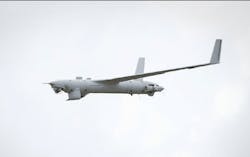Army surveys industry for small unmanned aircraft with communications relay payloads to protect command posts
ABERDEEN PROVING GROUND, Md. – U.S. Army researchers are surveying industry to find companies able to build small unmanned aerial vehicles (UAVs) with communications relay payloads to help protect military command posts.
Officials of the U.S. Combat Capabilities Development Command (DEVCOM) C5ISR Center, Engineering and Systems Integration (ESI) Directorate at Aberdeen Proving Ground released a request for information on Tuesday (W56KGU24C0022) for the Aerial Drone Platform For Command Post Survivability project.
The Army is interested in tethered and untethered aerial UAVs with communications relay payloads that can follow convoys of military land vehicles while moving and while temporarily halted. The drone must be able to take-off and land from stationary and moving ground vehicles.
Army experts particularly are interested in collision avoidance for the UAV to remain clear of physical obstructions, objects, and weather conditions like wind gusts. The drone also must be able to follow a ground vehicle at tactical speeds and in a non-planned designated route for the convoy.
Related: How “Near-Peer” Adversaries are Changing Command Posts and Battlefield Network Requirements
The Army particularly is interested in so-called Group 1 and Group 2 UAVs. Group 1 unmanned aircraft weigh 20 pounds or less, fly 1,200 feet or lower from the ground, and can fly as fast as 100 knots. Group 2 UAVs weigh between 21 and 55 pounds, can fly as high as 3,500 feet, and can fly as fast as 250 knots.
Those interested should submit 10-page unclassified white papers with descriptions of their companies' UAVs and capabilities, landing and takeoff capabilities, battery endurance, obstacle-avoidance capabilities, and other relevant information.
Email white papers to the Army no later than 26 April 2024 to [email protected], with "RFI: Aerial Drone Platform for command post survivability - YOUR COMPANY" in the subject line.
Email questions or concerns to the Army at [email protected].

John Keller | Editor-in-Chief
John Keller is the Editor-in-Chief, Military & Aerospace Electronics Magazine--provides extensive coverage and analysis of enabling electronics and optoelectronic technologies in military, space and commercial aviation applications. John has been a member of the Military & Aerospace Electronics staff since 1989 and chief editor since 1995.

